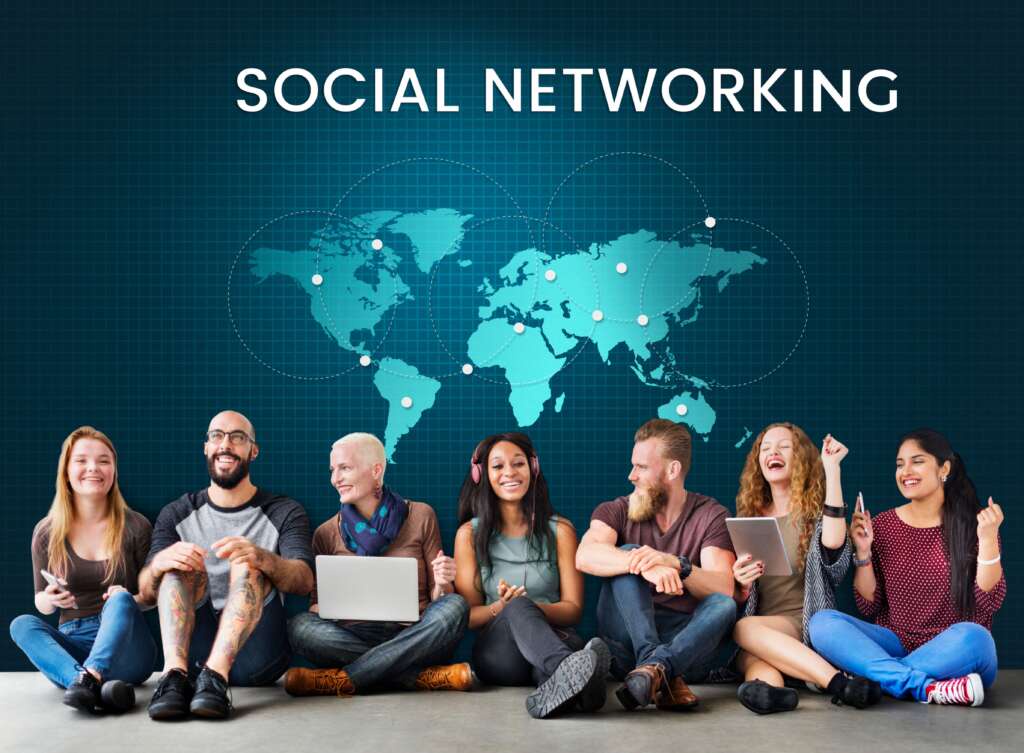Introduction to Social Networking
Social networking has become an integral part of our daily lives. Networking platforms have completely transformed the way we connect with others, allowing us to interact and communicate with people from all around the world. Whether it’s reconnecting with old friends, making new connections, or promoting our businesses, social networking has opened up a world of possibilities. With just a few clicks, we can share our thoughts, photos, and videos with our network of friends and followers. The power of connection that social networking provides is truly remarkable.
The History of Social Networking
Social networking is not a new phenomenon. It has been around for decades, albeit in a different form. These can be traced back to the early days of the Internet when online forums and chat rooms were popular. These platforms allowed people with common interests to come together and engage in discussions. However, it was not until the emergence of platforms like SixDegrees.com, Friendster, and MySpace in the late 1990s and early 2000s that social networking truly took off.
Key aspects of social networking
- Personal Profiles: Users typically create personal profiles on platforms, where they provide information about themselves such as their name, age, location, interests, and hobbies. Profiles often include profile pictures and cover photos to personalize the experience.
2. Connecting with Others: One of the primary functions of social networking platforms is to connect individuals with others. Users can search for friends, family, classmates, or colleagues and send them friend requests or follow their profiles to stay updated on their activities.
3. Content Sharing: Networking platforms allow users to share various types of content, including text posts, photos, videos, links, and status updates. This content can be shared publicly with all followers or privately with specific individuals or groups.
4. Engagement: Users can engage with each other’s content through likes, comments, shares, and reactions. These interactions help to foster connections, spark conversations, and create a sense of community among users.
5. Messaging: Many social networking platforms offer messaging features that allow users to communicate with each other privately. These messaging tools can be used for one-on-one conversations or group chats.
6. Privacy Settings: Social networking platforms typically provide users with options to control the privacy of their profiles and the content they share. Users can adjust settings to determine who can see their posts, who can send them friend requests, and who can message them.
7. Discovery and Exploration: Social networking platforms often include features for discovering new people, groups, and interests. Users can explore trending topics, join communities based on shared interests, and discover content recommended by the platform’s algorithms.
The Impact of Social Networking on Personal Relationships
Social networking has had a profound impact on personal relationships. It has made it easier than ever to stay connected with family and friends, regardless of distance. We can now share important milestones, such as birthdays and anniversaries, with our loved ones in real-time. This also made it possible to reconnect with old friends and classmates, bringing people back into our lives who we may have lost touch with otherwise. However, it is important to note that while social networking can enhance personal relationships, it should never replace face-to-face interaction and genuine human connection.
The Impact of Social Networking on Business and Professional Connections
Not only has social networking revolutionized personal relationships, but it has also had a significant impact on business and professional connections. Platforms like LinkedIn have become invaluable tools for professionals looking to expand their networks and advance their careers. Employers can now easily find and connect with potential candidates, while job seekers can showcase their skills and experience to a wide audience. Social networking has also opened up new avenues for businesses to reach and engage with their target audience. With the ability to directly interact with customers and receive instant feedback, businesses can tailor their products and services to meet the needs of their customers more effectively.
Psychology Behind Social Networking
- Human Connection: Social media is like a big digital playground where people from all over the world can meet and interact. It’s a place where you can make new friends, reconnect with old ones, and share bits of your life with them, like photos, thoughts, and experiences. Just like when you join a club or a team in real life, being part of social media platforms lets you feel like you belong to a community, even if it’s online.
- Feeling Included: Imagine you’re at a party and everyone cheers when you walk in – that’s kind of what it feels like to get likes and comments on your social media posts. It’s a way for others to show they appreciate what you’re sharing, whether it’s a funny meme, an inspiring quote, or a picture of your pet. Getting positive feedback on your posts can make you feel good about yourself and your place in the online world.
- Support and Encouragement: Sometimes life throws us curveballs, and when it does, social media can be a source of comfort and support. Whether you’re going through a tough time or celebrating a success, your online friends are there to cheer you on, offer advice, or simply lend a listening ear. It’s like having a big virtual support network that’s always there when you need it.
- Feeling Happy: Have you ever felt a little rush of excitement when your phone buzzes with a notification? That’s because getting likes and comments on social media releases a chemical called dopamine in your brain, which makes you feel happy and rewarded. It’s the same feeling you get when you win a game or eat your favorite dessert – except in this case, it’s triggered by the positive interactions you have online.
- Using Social Media Too Much: While social media can be a fun and rewarding place to hang out, spending too much time scrolling through your feeds can have its downsides. It’s easy to get sucked into the endless stream of posts and notifications, which can take away from other important parts of your life, like spending time with family and friends or pursuing hobbies and interests offline.
- Balancing Act: Finding the right balance between social media and real-life activities is key to maintaining a healthy relationship with technology. Setting boundaries, like limiting your screen time or taking regular breaks from social media, can help you stay grounded and connected to the world around you. Remember, social media is just one part of your life – don’t let it overshadow the other things that bring you joy and fulfillment.
The Benefits of Social Networking
The benefits of social networking are plentiful. It allows us to stay connected with friends and family, even when we are physically apart. It provides a platform for self-expression, allowing us to share our thoughts, ideas, and creativity with the world. It also enables us to discover new opportunities, whether it’s finding a job, joining a community organization, or starting a business. It fosters collaboration and knowledge-sharing, as we can connect with like-minded individuals who share our interests and passions. Moreover, it has become a powerful tool for social causes, allowing us to raise awareness and support causes that are important to us.

Limitations of Social Networking
While social networking has its benefits, it is not without its limitations. One of the main concerns is the issue of privacy. With the amount of personal information we share on these platforms, there is always a risk of that information falling into the wrong hands. Additionally, social networking can sometimes lead to feelings of envy and inadequacy as we compare ourselves to others’ carefully curated online personas. It can also be a breeding ground for cyberbullying and online harassment. It is important to be mindful of these risks and take steps to protect ourselves and our mental well-being when using social networking platforms.
The Future of Social Networking
The future of social networking is exciting and full of possibilities. As technology continues to advance, we can expect to see more immersive and interactive experiences on these platforms. Virtual reality and augmented reality are already starting to make their way into social networking, providing users with a more engaging and lifelike experience. Additionally, we can visualize further integration of artificial intelligence, allowing social networking platforms to better understand and cater to our individual preferences and needs. The future of social networking holds great potential for further connecting and enriching our lives in ways we can’t even imagine.
How to Effectively Use Social Networking Platforms
To effectively use social networking platforms, it is important to have a clear purpose and goal in mind. Whether it’s connecting with friends, promoting your business, or building professional connections, define what you want to achieve. Be authentic and genuine in your interactions, and avoid trying to present a perfect image of yourself. Engage with others by liking, commenting, and sharing their content. Build a network of like-minded individuals by joining groups and communities that align with your interests and values. Lastly, be mindful of the time you spend on social networking and set boundaries to ensure a healthy balance in your life.
Social Networking for Businesses and Brands
For businesses and brands, social networking has become an essential part of their marketing and communication strategies. It allows them to reach a wider audience and build brand awareness. To effectively use social networking for business, it is important to have a clear brand identity and message. Engage with your audience by providing valuable content and responding to their comments and messages. Use analytics tools to track the performance of your social media campaigns and make data-driven decisions. Collaborate with influencers and leverage user-generated content to expand your reach. Social networking provides endless opportunities for businesses and brands to connect with their customers and drive growth.
Conclusion: The Power of Connection through Social Networking
In conclusion, social networking has revolutionized the way we connect with others, both personally and professionally. It has brought people from all over the world closer together, providing a platform for meaningful interactions and relationships. However, it is important to approach social networking with caution and mindfulness, being aware of its benefits and limitations. By harnessing the power of connection that social networking provides, we can enhance our personal and professional lives, develop collaboration, and contribute to positive change. So, let’s embrace social networking and use it to build meaningful connections and make a difference in the world.
Don’t miss out—subscribe to our newsletter or follow us on social media for timely updates on our forthcoming articles.
Visit our website to read latest articles: https://workonpeak.org/blogs/


No comments yet